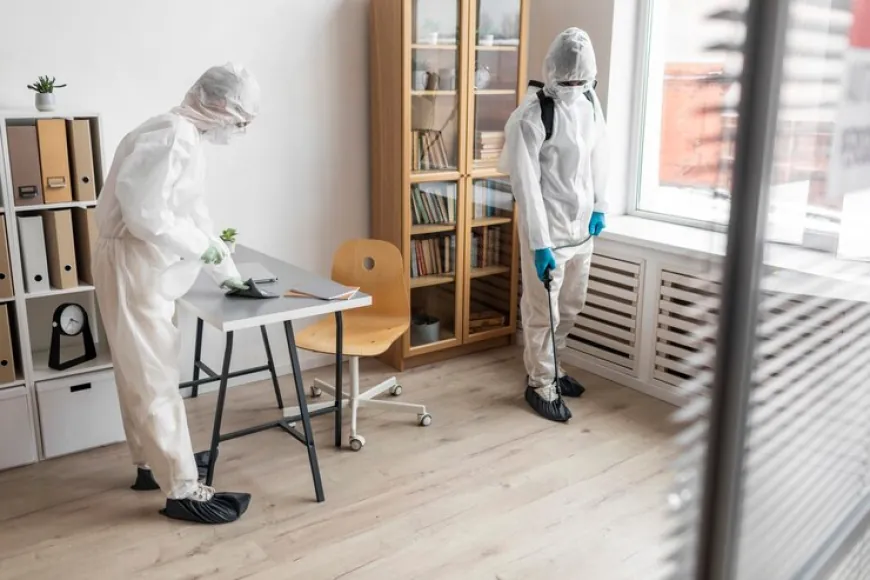Why Bedrooms Are Dust Mite Hotspots and How to Treat Them
For those searching for dust mite control and removal near me, the bedroom often becomes the primary area of concern.

Dust mites are microscopic pests that thrive in warm, humid environments, and unfortunately, our bedrooms provide the perfect habitat for them. These tiny creatures are invisible to the naked eye but can cause significant discomfort for those with allergies or asthma. Dust mites feed on dead skin cells and prefer soft, fabric-rich environments like beds, pillows, and carpets, making bedrooms one of their favorite places to live. Understanding why dust mites gravitate toward bedrooms and learning effective strategies for treating infestations can improve air quality and create a healthier space for sleep.
Dust Mite Control and Removal Near Me: Why It’s Essential
For those searching for dust mite control and removal near me, the bedroom often becomes the primary area of concern. Bedrooms typically contain soft furnishings, linens, and high humidity levels, which make them an ideal breeding ground for dust mites. Without effective dust mite control, these pests can accumulate quickly, leading to increased allergens in the air. This can exacerbate symptoms like sneezing, congestion, itchy eyes, and respiratory issues, especially for individuals with sensitivities. Tackling dust mite infestations in the bedroom is crucial to prevent long-term health issues and improve sleep quality.
Why Bedrooms Are Hotspots for Dust Mites
-
Warmth and Humidity
Dust mites thrive in warm and humid conditions, with temperatures between 68 and 77°F and humidity levels above 50%. Bedrooms often maintain a stable temperature due to heating or air conditioning, and the humidity generated from breathing and other daily activities can create the perfect environment for dust mites. Mattress and pillow materials can trap warmth and moisture, providing an ideal home for dust mites to flourish. -
Abundant Food Sources
Dust mites feed on dead skin cells, and as humans shed these cells constantly, our beds accumulate a steady supply of dust mite food. Every time we sleep, we shed skin cells, sweat, and oils, all of which contribute to a dust mite-friendly environment. Mattresses, pillows, and bedding can quickly become saturated with dust mites if they’re not regularly cleaned or protected. -
Soft and Fabric-Rich Environments
Dust mites prefer soft, fabric-covered surfaces that allow them to burrow and cling. Bedrooms are full of such surfaces, including mattresses, pillows, blankets, carpets, curtains, and upholstered furniture. The fibers in these items trap dust particles and dead skin, allowing dust mites to thrive undisturbed. Regular vacuuming is often insufficient in removing dust mites embedded deep within these fabrics, making bedrooms a high-risk area for infestations. -
Limited Ventilation
Bedrooms typically have limited ventilation, especially when windows are closed to maintain privacy or temperature control. Lack of airflow means that dust mites can continue to breed in humid, enclosed spaces. Proper ventilation and air circulation are critical to preventing high dust mite populations, which thrive in stagnant, undisturbed areas.
Effective Ways to Treat Dust Mite Infestations in Bedrooms
-
Wash Bedding Regularly
Bedding should be washed in hot water (at least 130°F) every week to kill dust mites and remove allergens. High temperatures are essential, as dust mites can survive normal washing cycles. Consider drying bedding on high heat as well, as this additional step will help eliminate any remaining dust mites. -
Use Allergen-Proof Mattress and Pillow Covers
Investing in allergen-proof covers for mattresses and pillows can make a significant difference in dust mite control. These covers create a barrier between you and the mites, preventing them from penetrating the fabric and feeding on skin cells. They’re typically made of tightly woven materials that are impermeable to dust mites but still breathable, keeping mattresses and pillows fresher for longer. -
Lower Humidity Levels
Since dust mites need moisture to survive, reducing humidity levels in the bedroom can be highly effective. Aim for a humidity level of 30-50% by using a dehumidifier or air conditioner. In areas with high natural humidity, a dehumidifier is particularly useful in helping to create a drier environment that’s inhospitable to dust mites. -
Replace Carpeting with Hard Flooring
Carpets are a notorious haven for dust mites, as they trap dust, skin cells, and humidity. Consider replacing bedroom carpets with hard flooring, such as wood, laminate, or tile, which is easier to clean and does not provide an environment for dust mites to thrive. Area rugs can be used to add warmth and comfort, but they should be washable and cleaned regularly. -
Vacuum Regularly with a HEPA Filter
Regular vacuuming is essential in reducing dust mite allergens, especially in areas like bedroom floors and carpets. Use a vacuum with a HEPA filter, as standard vacuums can release allergens back into the air. HEPA filters trap small particles, including dust mite allergens, providing a more effective clean. Don’t forget to vacuum mattresses, curtains, and upholstered furniture, which are also prime dust mite locations. -
Freeze Soft Items
For items that cannot be washed in hot water, such as stuffed animals, freezing can be an effective alternative. Place soft items in a plastic bag and leave them in the freezer for 24 hours to kill dust mites. Once removed, shake out the items to release dead mites and allergens before returning them to the bedroom. -
Use Anti-Allergen Sprays
Anti-allergen sprays are designed to neutralize dust mite allergens on contact, providing a convenient way to reduce allergens on bedding, carpets, and other soft surfaces. These sprays don’t kill dust mites but help neutralize proteins that trigger allergic reactions, providing some relief for allergy sufferers. -
Regularly Clean Curtains and Blinds
Curtains and blinds are frequently overlooked dust traps in bedrooms. Dust mites can easily accumulate on these surfaces, especially if they’re not cleaned regularly. Washing curtains and wiping down blinds every few weeks can help control dust mite populations. Consider replacing fabric curtains with easy-to-clean blinds or shades, which can reduce dust buildup. -
Consider Using an Air Purifier
Air purifiers with HEPA filters are effective in capturing airborne dust mite allergens. Placing an air purifier in the bedroom can help reduce the concentration of allergens in the air, improving overall air quality. Air purifiers work best in combination with regular cleaning practices, as they only address airborne particles. -
Minimize Clutter and Dust-Covered Surfaces
Dust mites love undisturbed surfaces where dust can collect. Minimizing clutter on dressers, shelves, and other bedroom surfaces can reduce dust buildup and make cleaning easier. Keep items stored in drawers or closets, and regularly dust surfaces to prevent dust mites from accumulating.
Conclusion
Bedrooms are a haven for dust mites, given the warmth, humidity, and abundance of soft surfaces. Fortunately, there are several effective methods for reducing dust mite populations and minimizing allergens in your bedroom. By following these tips—washing bedding regularly, using protective covers, lowering humidity, and vacuuming with HEPA filters—you can create a healthier sleeping environment. Dust mite control is an ongoing process, and consistent cleaning and preventive measures are essential to keeping these allergens at bay. With the right approach, you can significantly reduce dust mites in your bedroom, improving indoor air quality and making your home a more comfortable space for restful sleep.
What's Your Reaction?
 Like
0
Like
0
 Dislike
0
Dislike
0
 Love
0
Love
0
 Funny
0
Funny
0
 Angry
0
Angry
0
 Sad
0
Sad
0
 Wow
0
Wow
0



















































